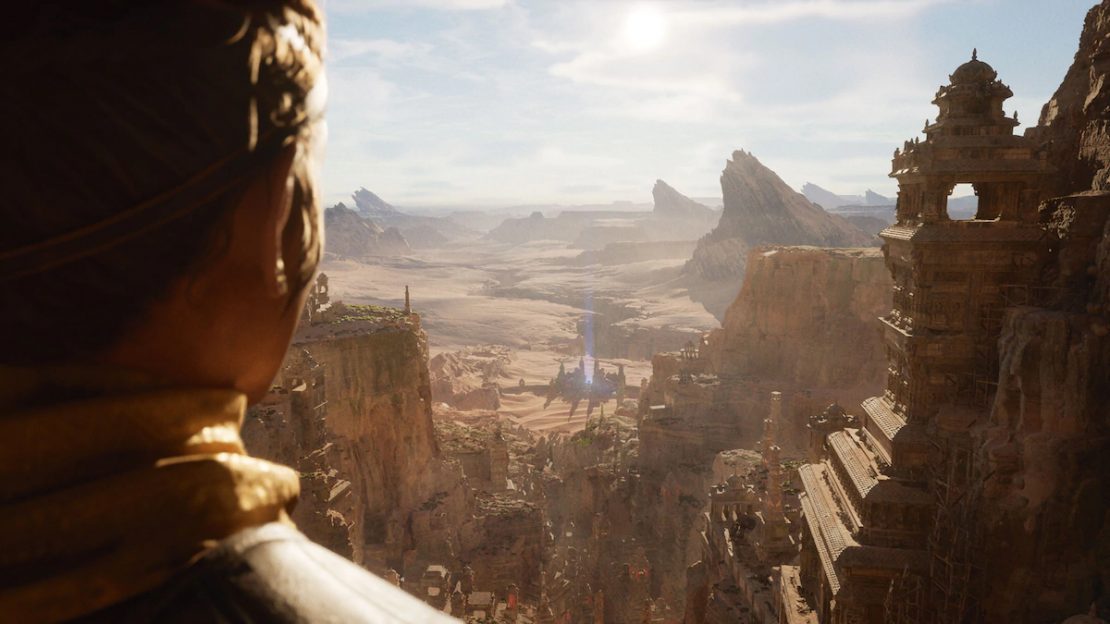QD Reacts: Unreal Engine 5

Gaining attention in 1998 with the release of the very first Unreal game, Unreal Engine is about to get its fifth version. Announced on May 13th, this future reference of video game development tools has been in the pipeline for 2 years now, scheduled for a late 2021 launch, aiming at the next gen embodied by the PlayStation 5 and Xbox Series X. Can’t wait to see what this technology will bring to us, gamers? Follow the guide, for a first analysis by one of our in-house specialists!
Let’s start with a pretty simple one: what is Unreal Engine used for?
Anthony – Lead Maya Tools Developer
We tend to simplify by using the generic term “game engine,” but in reality the Unreal Engine is a full development environment for game creation, composed of engines and tools. When we talk about the Unreal Engine, we first think of its rendering engine, but it also comes with an audio engine, for sound effects and music, a physics engine for simulation, an animation engine for character movements, an AI engine mainly dedicated to navigation – “pathfinding” – and a whole bunch of other functions… It also comes with tools, such as a map editor, a VFX editor, a gameplay editor, and so on… In short, you have everything you need to assemble the elements of a game and make it playable!
Simply put, if I have access to this engine, can I create a video game on my own?
Yes, it’s possible. Technically, the development environment contains everything you need to design a game from A to Z. Well, it takes some skills to address all aspects of game creation, but technically you could achieve it.
Who exactly is this game engine for?
Historically it was made for the big studios. The license was quite expensive and you needed a good technical level to be able to use it. Nowadays it’s much simpler, well documented and more affordable. So it has become a very serious option for smaller studios, even for small independent teams. The editor is even available for free, so anyone can learn to use it.

As a developer, what are the major features of Unreal Engine 5 so far?
There’s a lot of new stuff here. Apart from compatibility with the next gen, I noted two main features: Lumen and Nanite. Lumen is a new technology that dynamically calculates the overall illumination of a scene, and Nanite is a 3D geometry management system that allows you to display a huge number of triangles on the screen. These two points are very important, they require a lot of effort from the developers. Usually, a large part of game lighting is “static,” i.e. pre-calculated and not modifiable by the player. Sometimes our game character may be wearing a light source, such as a flashlight, but the dynamic lighting is very simple. You only have the direct impact of the light source and usually only one shadow; you don’t have the rest of the light propagation in the room at all, with much bouncing. This calculation is too complex to be rendered in real time in the game, so we have to pre-calculate it and mix it with dynamic lighting for the result to be realistic. Lumen technology allows you to do this calculation in real time, dynamically; theoretically you don’t need to pre-calculate the lighting. This could save artists a lot of time!
And the same goes for Nanite: preparing the graphic assets to adapt them to a real-time display requires a lot of effort. We have to make gradient versions of our assest to limit the number of triangles on the screen. With Nanite, in theory we will be able to import directly the very high resolution version of an asset. So if we can really take the high-resolution versions and send them into the game without any additional operation, it will save a lot of time for the artists.
The first Unreal Engine 5 demo is very impressive, from a neophyte’s point of view; as a developer, how do you feel about it?
I would say that what we saw in the demo is almost more impressive for me as a developer than it can be for a neophyte! Being able to display so much detail and have a dynamic overall lighting, it’s quiet amazing! And it’s not just because of the power of next gen hardware; they’ve really put some very interesting things into this new rendering engine, for sure. In fact, during the first viewing, I was very careful, assuming that if it looked too good to be true, it probably wasn’t true at all! But after studying the video closely, Epic’s approach makes sense to me. It remains to be seen what the limitations of the system are, because there are bound to be limitations. For example, as of today we haven’t seen everything about the management of transparency or reflection. The demo doesn’t show a close-up on the character’s hair and there isn’t much vegetation. We’re gonna have to wait to know if everything is compatible with Lumen and Nanite.
What is Unreal Engine going to bring to gamers?
First of all, a real gap in overall visual quality. There will clearly be a gain in staging and atmosphere, if it’s used well. And we’re going to have much larger and more detailed environments. I think more small studios that will deliver spectacular results, on a modest budget. So indirectly, the players are going to benefit from that.
And from a development standpoint?
For coders and artists, potentially a lot of production time can be saved, which opens up a lot of possibilities: either do the same thing as before but with smaller deadlines, budgets and teams. Or keep the same constraints, but put the saved efforts on other aspects, to improve the overall quality of the game. In both cases, it promises a lot of changes in the way games are made. But beware, these time savings don’t apply to all jobs, it only applies to rendering. You can’t magically apply a formula and predict shorter iteration times for all games, it’s still very project-dependent. And you also have to keep in mind that games are more and more multi-platform – PC, consoles, mobile. So these new features have to be available on all these platforms, of course. At the end of the day, it’s very exciting but there are still many questions left unanswered. Let’s wait until we have access to the full engine to assess its real impact.
Do you have any advice for those who want to get started on Unreal Engine? Anthony
First and foremost, I would say that the most important thing is to learn English! The software is free, so if you’re motivated, all you have to do is get started. There are tons of tutorials on the net and the documentation is crystal clear. On the other hand, the most interesting resources are in English, so mastering the language seems to me to be the essential prerequisite.
Well, thank you Anthony for this expert opinion! As a reminder, version 5 of Unreal Engine is expected to be in the test phase in early 2021, with a full launch planned for the fall.








